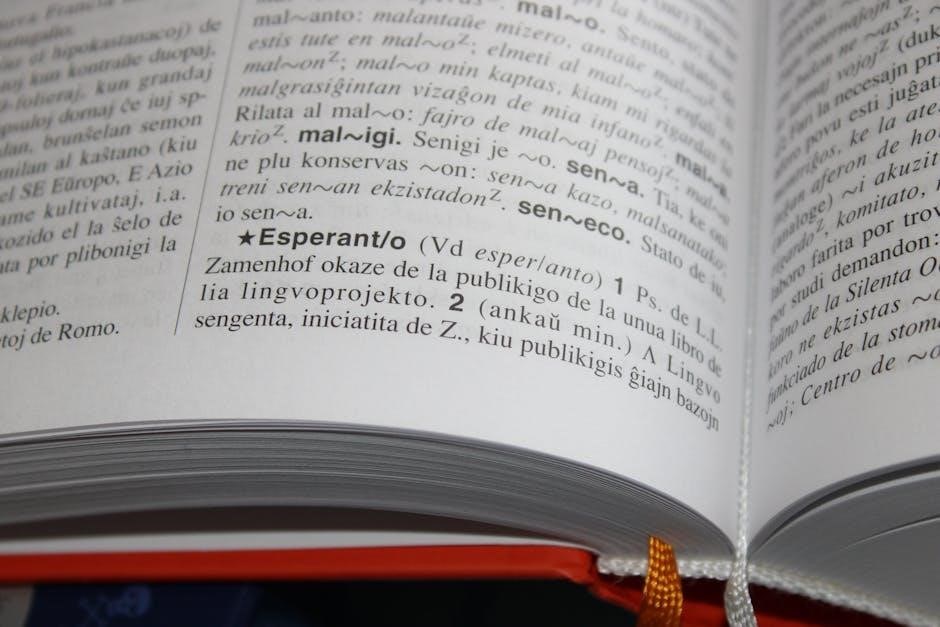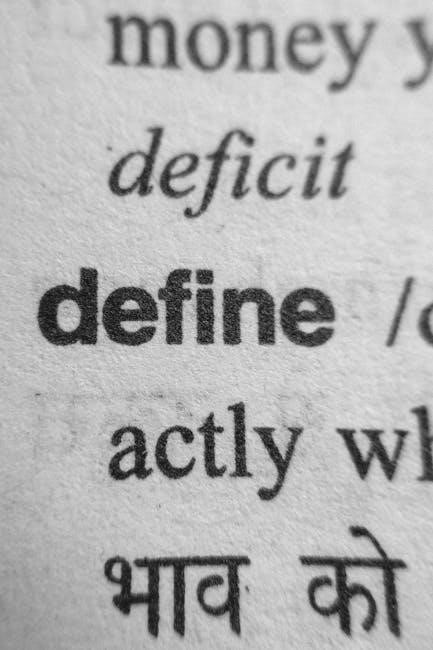Yiddish, a language blending Middle High German and Hebrew, holds rich cultural significance. A Yiddish dictionary PDF serves as a vital tool for exploring its heritage and vocabulary.
What is Yiddish?
Yiddish is a language that emerged in the 10th century as a fusion of Middle High German, Hebrew, Aramaic, and other languages, primarily spoken by Ashkenazi Jews in Central and Eastern Europe. It is written in the Hebrew alphabet and has a distinctive grammar and vocabulary influenced by its diverse linguistic roots. Yiddish became a vital part of Jewish culture, serving as a vernacular for daily life, literature, theater, and music. Over time, it evolved into a rich, expressive language with unique idiomatic phrases and a blend of humor and wisdom. Despite its decline in the 20th century due to assimilation and the Holocaust, Yiddish remains a symbol of Jewish heritage and identity, with ongoing efforts to preserve and revitalize it in modern times.
Importance of Yiddish in Cultural Context
Yiddish holds profound cultural significance as a bridge to Jewish heritage, literature, and traditions. It was the lingua franca of Ashkenazi Jews for centuries, enriching folklore, theater, and music. Yiddish dictionaries are essential for accessing classic works and understanding idiomatic expressions that reflect Jewish humor, wisdom, and resilience. They preserve linguistic nuances, enabling scholars and enthusiasts to connect with historical texts and cultural practices. In modern times, Yiddish dictionaries support revitalization efforts, fostering appreciation for this unique language. By providing translations and explanations, they ensure Yiddish remains a vibrant part of cultural identity, bridging past and present for future generations.
Why Use a Yiddish Dictionary?
A Yiddish dictionary is an indispensable resource for understanding and engaging with the language. It provides precise translations, pronunciation guides, and contextual examples, making it invaluable for learners and scholars alike. Whether for academic research, cultural enrichment, or practical communication, a Yiddish dictionary bridges linguistic gaps. It also offers insights into idiomatic expressions and historical terms, preserving the richness of Yiddish heritage. For those exploring Jewish literature, folklore, or everyday conversations, a dictionary ensures accuracy and clarity. Additionally, modern Yiddish dictionaries often include updated vocabulary, making them relevant for contemporary usage. This tool is essential for anyone seeking to delve into the depth and beauty of the Yiddish language, fostering both learning and cultural connection.

The Importance of Yiddish Dictionaries
Yiddish dictionaries are crucial for preserving linguistic heritage, aiding language learning, and fostering cultural understanding. They provide essential tools for scholars, learners, and enthusiasts, ensuring Yiddish remains accessible and vibrant.

Role in Language Preservation
Yiddish dictionaries play a vital role in preserving the linguistic and cultural heritage of the Yiddish language. They serve as comprehensive resources for documenting and standardizing Yiddish vocabulary, ensuring its survival for future generations. By providing detailed definitions, pronunciation guides, and example sentences, these dictionaries help maintain the language’s integrity and accessibility. They are particularly important for learners and scholars, offering a bridge between Yiddish and other languages like English or Hebrew. Many dictionaries, such as those by Uriel Weinreich, include etymological insights, enriching the understanding of Yiddish’s historical evolution. Additionally, offline accessibility ensures that these resources remain available even without internet connectivity. Overall, Yiddish dictionaries are indispensable tools for safeguarding a language that is deeply rooted in Jewish culture and history, fostering its continued use and appreciation worldwide.
Enhancing Language Learning
Yiddish dictionaries in PDF format are invaluable tools for language learners, offering comprehensive vocabulary, clear definitions, and pronunciation guides. These resources provide learners with the ability to explore Yiddish independently, fostering self-study and linguistic growth. Offline accessibility ensures uninterrupted learning, while advanced search functionality allows quick lookup of words. Example sentences enhance understanding by providing context, making language acquisition more intuitive. Many dictionaries, such as Uriel Weinreich’s, include romanized Yiddish, catering to learners unfamiliar with the Hebrew alphabet. Additionally, these dictionaries often cover modern and historical usage, bridging gaps for learners at various proficiency levels. By offering detailed etymological insights and practical communication aids, Yiddish dictionaries empower learners to master the language effectively, making them indispensable for both beginners and advanced students alike.
Facilitating Cultural Understanding
Yiddish dictionaries serve as bridges to the cultural and historical heritage of Yiddish-speaking communities. By providing translations and explanations of idiomatic expressions, these resources offer insights into traditional customs, folklore, and daily life. The inclusion of example sentences and etymological notes highlights the language’s unique blend of influences, from Hebrew to Middle High German. This cultural depth allows users to understand the nuances of Yiddish literature, music, and art. Moreover, dictionaries like Uriel Weinreich’s work often include academic terminology, enabling scholars to explore the language’s evolution. By preserving these cultural elements, Yiddish dictionaries become essential tools for anyone seeking to connect with the rich tapestry of Ashkenazi Jewish heritage, making them invaluable for cultural enthusiasts and researchers alike.

Historical Background of Yiddish Dictionaries
Yiddish dictionaries emerged to document a language shaped by Jewish diasporic experiences. Early works, like Harkavy’s 1928 edition, laid the groundwork for modern lexicography, bridging cultural and linguistic gaps.
Early Developments in Yiddish Lexicography
Early Yiddish lexicography began with rudimentary glossaries and word lists, often embedded in religious texts; These initial efforts were crucial for standardizing the language. Alexander Harkavy’s 1928 dictionary marked a significant milestone, providing comprehensive translations and establishing a foundation for future works. The evolution of Yiddish dictionaries reflects the language’s adaptability and cultural significance.
Evolution Over the Centuries
Yiddish lexicography has undergone significant transformations over the centuries, adapting to linguistic and cultural shifts. Early dictionaries like Alexander Harkavy’s 1928 edition laid the groundwork, offering bilingual translations and fostering standardization. Modern advancements introduced digital formats, such as PDF dictionaries, enhancing accessibility and usability. These resources now include pronunciation guides, example sentences, and advanced search features, catering to both scholars and casual learners. The evolution reflects Yiddish’s enduring relevance, with contemporary tools like offline accessibility and audio pronunciations meeting the needs of a diverse user base. This progression ensures Yiddish remains a vibrant, accessible language for future generations.
Influence of Harkavy’s Work
Alexander Harkavy’s 1928 Yiddish-English-Hebrew dictionary marked a pivotal moment in Yiddish lexicography, setting a standard for clarity and comprehensiveness. His work introduced reliable translations and standardized spellings, influencing future dictionaries. Harkavy’s approach emphasized accessibility, making Yiddish more understandable to diverse learners. His dictionary’s digital versions, such as PDF formats, ensure its enduring relevance, offering offline access and pronunciation guides. This legacy underscores the importance of his contributions in preserving and promoting Yiddish language and culture, making it a cornerstone for both academic and everyday use.

Key Features of a Yiddish Dictionary PDF
- Comprehensive Vocabulary: Includes a wide range of Yiddish words for extensive language coverage.
- Pronunciation Guides: Provides clear pronunciation aids for accurate language learning.
- Offline Accessibility: Enables usage without internet, ensuring convenience for all users.
- Advanced Search Functionality: Allows quick and efficient word lookup.
- Example Sentences: Offers contextual usage to enhance understanding and application.
Comprehensive Vocabulary
A Yiddish dictionary PDF typically includes an extensive collection of Yiddish words, ensuring broad coverage of the language. It encompasses modern terminology, traditional phrases, and dialect variations, such as Polish (Central) Yiddish and Western Yiddish. The vocabulary is carefully curated to reflect the language’s evolution, including words from Hebrew, Aramaic, and other influences. Many dictionaries, like Uriel Weinreich’s, feature over 15,000 entries, providing depth and clarity. They also include academic and cultural terms, making them invaluable for scholars and learners alike. The comprehensive nature of these dictionaries ensures users can explore Yiddish in all its richness, from everyday expressions to literary and historical language.
Pronunciation Guides
Pronunciation guides are a key feature of Yiddish dictionary PDFs, enabling users to master the correct intonation and accent. Many dictionaries include audio features or phonetic transcriptions, allowing learners to hear and replicate words accurately. For instance, modern dictionaries provide Romanized Yiddish, making it easier for non-native speakers to grasp pronunciation. These guides are particularly useful for words with Hebrew or Aramaic origins, which may have unique sounds unfamiliar to learners. Additionally, some resources offer detailed vowel charts and stress patterns, ensuring clarity. By integrating pronunciation aids, Yiddish dictionaries bridge the gap between written and spoken language, fostering fluency and confidence in communication.
Offline Accessibility
Offline accessibility is a crucial feature of Yiddish dictionary PDFs, allowing users to utilize the resource without an internet connection. This makes it ideal for learners in areas with limited connectivity or those who prefer offline study. Many modern Yiddish dictionaries are designed as downloadable PDFs or standalone apps, ensuring uninterrupted access. For example, the English-Yiddish (romanized) dictionary operates entirely offline, providing instant translations and definitions. This feature is particularly beneficial for travelers or individuals who rely on mobile devices. Offline accessibility also enhances portability, enabling users to carry comprehensive linguistic tools wherever they go. With offline capabilities, Yiddish dictionaries remain a reliable and practical resource for language learners and scholars alike, fostering continued use and exploration of the language.
Advanced Search Functionality
Advanced search functionality in Yiddish dictionary PDFs enhances user experience by enabling quick and precise word lookups. Many modern dictionaries incorporate robust search tools, allowing users to instantly find definitions, translations, and examples. For instance, features like keyword search, wildcard queries, and phonetic matching help users locate terms efficiently. Some dictionaries even offer voice search, enabling pronunciation-based queries. These capabilities are particularly useful for learners who may not be familiar with Yiddish spelling or pronunciation. Additionally, advanced search functions often include filters for part of speech, etymology, or usage context, making them invaluable for both casual learners and academic researchers. By streamlining access to linguistic information, advanced search functionality ensures that Yiddish dictionaries remain practical and user-friendly resources for diverse audiences.
Example Sentences for Context
Example sentences in Yiddish dictionaries provide crucial context, illustrating how words are used in real-life scenarios. These sentences clarify nuances in meaning, pronunciation, and cultural usage, making language learning more effective. By offering practical examples, dictionaries help users grasp idiomatic expressions and grammatical structures. For instance, a word like “chutzpah” might be paired with a sentence demonstrating its bold or cheeky connotation. This feature is especially valuable for learners unfamiliar with Yiddish idioms or humor. Many modern dictionaries include example sentences that reflect contemporary usage, ensuring relevance and accessibility. This approach bridges linguistic gaps and enriches the learning experience, making Yiddish more accessible to diverse audiences while preserving its rich cultural heritage.

Available Resources and Dictionaries
Yiddish dictionaries are widely available online, offering comprehensive vocabulary and cultural insights. Notable resources include Uriel Weinreich’s Modern English-Yiddish Dictionary and the extensive YIVO archives, both accessible as downloadable PDFs.
Notable Yiddish Dictionaries
Uriel Weinreich’s Modern English-Yiddish Dictionary stands out as a seminal work, offering a robust lexicon of Yiddish terms with clear definitions and contemporary relevance.
Alexander Harkavy’s 1928 Yiddish-English-Hebrew Dictionary remains a foundational resource, providing detailed entries that capture the language’s evolution and cultural nuances.

The YIVO Institute’s archives house over 100 Yiddish dictionaries, covering academic terminology, etymology, and foreign influences, making them invaluable for scholars and learners alike.
These dictionaries not only preserve Yiddish but also bridge gaps between languages, fostering understanding and accessibility for diverse audiences.
Uriel Weinreich’s Contributions
Uriel Weinreich’s Modern English-Yiddish Dictionary is a landmark contribution to Yiddish lexicography, offering a comprehensive and accessible resource for learners and scholars.
His work includes a vast vocabulary with clear definitions, pronunciation guides, and example sentences, ensuring practical usage and linguistic accuracy.
Weinreich’s dictionary not only facilitates language learning but also supports cultural preservation by documenting Yiddish terms and their cultural contexts.
Its offline accessibility and user-friendly design make it an indispensable tool for understanding and engaging with the Yiddish language.
Weinreich’s contributions have significantly advanced the field of Yiddish studies, providing a reliable and enduring resource for future generations.
YIVO Archives and Collections
The YIVO Institute for Jewish Research houses an extensive collection of Yiddish dictionaries and linguistic resources, totaling over 100 volumes.
These archives include works focusing on academic terminology, etymology, and foreign words incorporated into Yiddish, offering deep insights into the language’s evolution.
The YIVO archives are a vital resource for scholars and learners, providing access to rare and comprehensive Yiddish dictionaries in PDF formats for easy download and research.
Subject headings cover various aspects of Yiddish, including Hebrew, Lithuanian, Polish, Russian, and Ukrainian influences, highlighting the language’s multicultural roots.
These collections not only aid in linguistic scholarship but also preserve Yiddish cultural heritage, making them indispensable for both academic and personal use.

Challenges in Creating Yiddish Dictionaries
Creating Yiddish dictionaries faces challenges like evolving language dynamics, limited scholarly resources, and standardization issues, complicating efforts to maintain accuracy and relevance for modern users.
Evolving Language Dynamics
The dynamic nature of Yiddish poses significant challenges for dictionary creation. As the language evolves, new words emerge, and older terms fall out of use or change in meaning. This requires constant updates to maintain relevance. Lexicographers must balance traditional vocabulary with modern adaptations, especially as Yiddish interacts with other languages like English and Hebrew. The integration of contemporary slang and technological terms further complicates the process. Additionally, dialect variations across regions add layers of complexity. The digital age has accelerated these changes, making it essential for dictionaries to adapt quickly. This fluidity ensures Yiddish remains a living language but also creates ongoing challenges for those documenting its ever-changing landscape.
Limited Scholarly Resources
One significant challenge in creating Yiddish dictionaries is the scarcity of comprehensive scholarly resources. While historical dictionaries like those by Uriel Weinreich and Alexander Harkavy provide foundational knowledge, modern Yiddish dictionaries often lack the depth needed for contemporary usage. Many existing resources are outdated or limited in scope, failing to address evolving language dynamics. This scarcity is particularly evident in the absence of dictionaries that cater to modern linguistic needs, such as technical terms or slang. Additionally, the availability of digitized Yiddish dictionaries is uneven, with many rare or academic works remaining inaccessible to the general public. This limited access hinders both casual learners and serious scholars, making it difficult to maintain and expand Yiddish language studies in an increasingly digital world.
Standardization Issues
Standardization poses a significant challenge in developing Yiddish dictionaries, as the language exhibits diverse dialects and spelling variations. For instance, Polish (Central) Yiddish and Western Yiddish differ in pronunciation and orthography, leading to inconsistencies in dictionary entries. The YIVO standard, while widely recognized, is not universally adopted, resulting in conflicting spellings and definitions across dictionaries. Additionally, the inclusion of modern slang and technical terms complicates efforts to create a unified lexicon. Digital tools, such as pronunciation guides, further highlight these disparities, as they often reflect specific dialects rather than a standardized form. These issues underscore the need for a more cohesive approach to Yiddish lexicography, balancing linguistic diversity with the practical demands of clear communication and education.

Modern Usage and Benefits
Modern Yiddish dictionaries, especially in PDF formats, offer accessible tools for cultural preservation, academic research, and practical communication, fostering linguistic revival and bridging historical gaps efficiently.
Cultural Preservation Efforts
Yiddish dictionary PDFs play a crucial role in preserving the language and cultural heritage of Yiddish-speaking communities. By providing accessible resources, these dictionaries help maintain the richness of Yiddish traditions.
Offline accessibility ensures that users can engage with the language without internet constraints, making it a valuable tool for education and cultural enrichment.
Comprehensive vocabularies and example sentences offer insights into Yiddish expressions, fostering a deeper understanding of its cultural context.
These resources are essential for educators, researchers, and enthusiasts aiming to keep Yiddish alive and vibrant for future generations.
Academic and Research Applications
Yiddish dictionary PDFs are invaluable for academic and research purposes, offering scholars a robust tool for linguistic analysis.
These resources provide comprehensive vocabularies, etymological insights, and pronunciation guides, enabling detailed study of Yiddish’s unique linguistic structure.
Researchers can explore rare terms, archaic expressions, and dialect variations, making these dictionaries essential for historical and comparative linguistic studies.
The inclusion of example sentences and cultural context aids in understanding nuanced meanings, while advanced search functionality facilitates efficient exploration.
Offline accessibility ensures uninterrupted research, making these PDFs indispensable for academics and linguists worldwide.
Practical Communication Aids
Yiddish dictionary PDFs serve as essential tools for practical communication, bridging linguistic gaps for learners and native speakers alike.
With comprehensive vocabularies and pronunciation guides, these resources enable accurate speaking and listening skills, fostering clearer interactions.

Offline accessibility ensures uninterrupted use, making them ideal for travel or everyday conversations without internet reliance.
Advanced search functionality allows quick word lookup, aiding real-time communication in personal or professional settings.
These dictionaries empower users to navigate Yiddish effectively, preserving its use in modern contexts while maintaining cultural authenticity.
Yiddish dictionaries, especially in PDF formats, remain vital tools for preserving and communicating Yiddish culture, ensuring its linguistic heritage endures for future generations to explore and appreciate.
Future of Yiddish Dictionaries
The future of Yiddish dictionaries, particularly in PDF formats, lies in their ability to adapt to digital advancements while preserving linguistic heritage. As technology evolves, dictionaries are likely to become more interactive, incorporating features like audio pronunciation guides and advanced search functionalities. The integration of artificial intelligence could enhance user experiences, offering personalized learning paths and real-time translations. Additionally, there is a growing emphasis on creating mobile-friendly PDFs to ensure accessibility across devices. Collaborative efforts between scholars and digital platforms will be crucial in updating these resources to include modern terminology while maintaining historical accuracy. By bridging traditional and contemporary needs, Yiddish dictionaries will continue to serve as vital tools for language learners, researchers, and cultural enthusiasts alike.
- Digital innovation will enhance accessibility and functionality.
- Integration of multimedia elements like audio and video.
- Collaborative efforts to update and expand vocabulary.
- Focus on mobile-friendly and interactive designs.
Encouraging Continued Use and Development
Encouraging the continued use and development of Yiddish dictionary PDFs is essential for preserving and promoting the language. These resources provide accessible, offline access to comprehensive vocabulary, pronunciation guides, and example sentences, making them invaluable for learners and scholars. Efforts to update and expand these dictionaries ensure they remain relevant in a modern context. The inclusion of advanced search functionality and multimedia features enhances user engagement. Collaborative initiatives, such as those involving the YIVO archives, highlight the importance of community involvement in maintaining linguistic heritage. By supporting these tools, we foster a deeper understanding and appreciation of Yiddish, ensuring its legacy endures for future generations.
- Highlight the importance of accessibility and updates.
- Emphasize the role of community and collaboration.
- Focus on multimedia enhancements for better engagement.
- Link preservation efforts to cultural and academic value.
